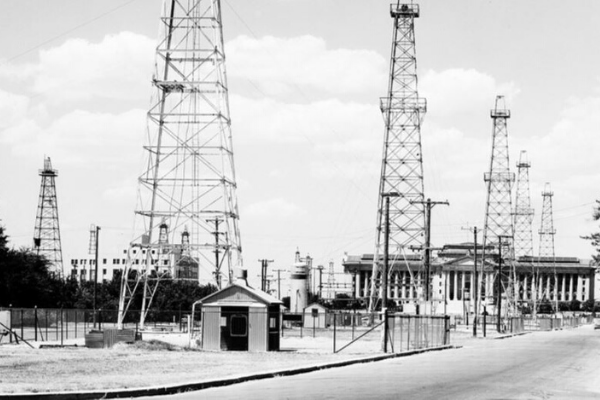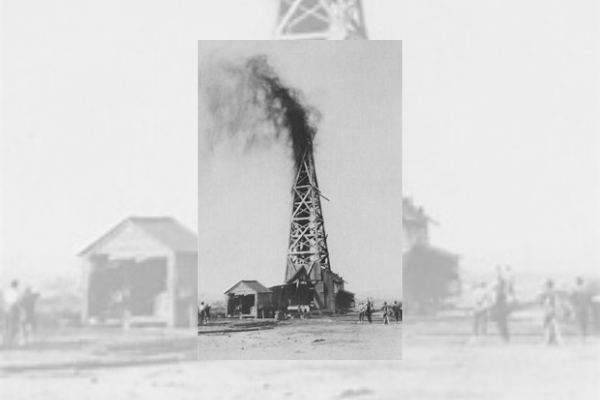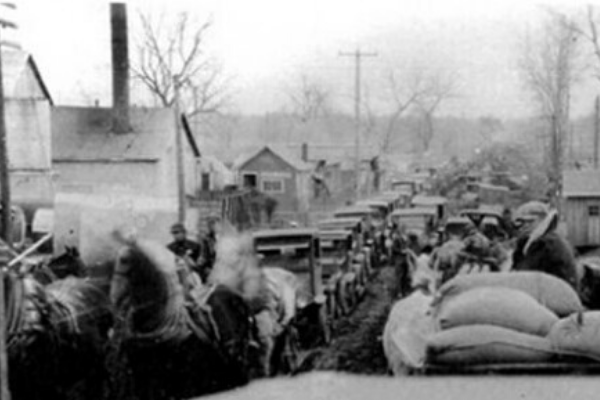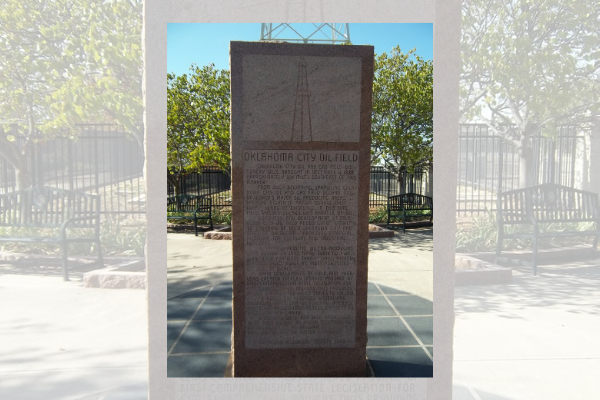OIL AND OKLAHOMA STATEHOOD
The “Old West” was a period of cattle drives, cowboys and gunslingers, Billy the Kid and Jesse James, Wyatt Earp and Geronimo, the Battle of the Little Bighorn and the Gunfight at the OK Corral. Although it has been celebrated in celluloid for more than 100 years, historians contend the Old West lasted only about 30 years, from the end of the Civil War in 1865 until around 1895.
The history of oil and natural gas production in Oklahoma indicates otherwise. Continental Resources CEO and multibillionaire Harold Hamm and the late Aubrey McClendon, co-founder and CEO of Chesapeake Energy Corp., were not this state’s first wildcatters. They were preceded by J. Paul Getty, Harry Sinclair, William G. “Bill” Skelly, Thomas Gilcrease, Frank Phillips, E.W. Marland, Robert F. Garland and Robert F. Galbreath.
These men were risk-takers who opened up oil fields which made Oklahoma a national and global “player.” The exploits of these gamblers and their companies, and many of their successors, are recounted in several books, starting with “Oil in Oklahoma,” written by Tulsan Robert Gregory and published in 1976 by the late James C. Leake of Muskogee (90 pages).
Other fine sources of information include “A History of the Greater Seminole Oil Field,” by Louise Welsh, Willa Mae Townes and John W. Morris, (138 pp, ©1981 Oklahoma Heritage Association); “On the Oil Lands with Cities Service,” by William Donohue Ellis, (483 pages, ©1983 Cities
Service Oil and Gas Corp.); and “Prospects to Prosperity: The Story of Oklahoma’s Oil and Gas Industry,” written by Oklahoma City attorney and prolific author Bob Burke (356 pages, ©2012, commissioned by the Oklahoma Independent Petroleum Association).All four books are flush with photos of the Oklahoma energy industry.
STATE ECONOMY HAS LONG BEEN TIED TO THE OIL/GAS INDUSTRY
Regardless of how many times politicians and business leaders admonish Oklahomans to diversify the economy, this state still depends heavily on the oil and gas industry. The state Corporation Commission, which regulates the energy industry, estimates that in the past 122 years half a million oil/ gas wells have been drilled in Oklahoma – and agency records showed 141,700 active wells in service in 75 counties (all but Adair and Choctaw) this past June.
Nearly 70 million barrels of oil and more than a trillion cubic feet of natural gas were produced in Oklahoma in May through August, according to the U.S. Energy Information Administration. Because of its prominence, oil is commemorated in several place names. The city of Glenpool, for example, bears its eponymous name from the oilfield south of Tulsa that was Oklahoma’s first major oil play and ultimately produced 340 million barrels of crude oil. Barnsdall, in Osage County, originally was named for Osage Chief James Big-heart but was renamed for Theodore N. Barnsdall and his oil company. Cromwell, in Seminole County, is named for oilman Joe I. Cromwell, who platted the original town.
Slick, southeast of Bristow in Creek County, is named for Tom Slick, who made a fortune from the 32 square-mile Cushing oilfield after drilling the discovery well a mile north of Drumright (which was not yet a town) in 1912. Charles Page Boulevard, which connects Sand Springs to Tulsa, is named for philanthropist Charles Page, who got rich in the Glenn Pool.
The Phillips Petroleum Co., incorporated in 1917, and its Phillips 66 gas stations, were named for founder Frank Phillips. In addition, two towns in the Texas Panhandle merged in 1938 under the name of Phillips in recognition of the presence of Phillips Petroleum Co. in the area. In 1952, a section of Interstate 44 in Tulsa was designated by then-Gov. Johnston Murray as Skelly Drive, in honor of oilman Bill Skelly. The Philbrook Museum of Art in Tulsa was the historic home of Waite Phillips, brother of Frank Phillips and himself an oilman who donated his residence to the City of Tulsa and donated Philmont, his ranch in New Mexico, to the Boy Scouts of America. Similarly, oilman Thomas Gilcrease sold his museum in Tulsa and its myriad artworks, along with his sandstone home and 13 acres, to the City of Tulsa.
FIRST COMMERCIAL OIL WELL WAS DRILLED AT BARTLESVILLE; GETTY, PHILLIPS GET RICH
The search for oil in Oklahoma began in the 1870s, Burke writes, but not until 1897 – a decade before statehood – was the first commercial oil well brought in: the Nellie Johnstone #1 at Bartlesville. In the 10 years following the Nellie Johnstone discovery, Oklahoma’s oil production skyrocketed from 1,000 barrels to more than 43 million barrels annually. (One barrel of oil is equivalent to 42 gallons.)
George Franklin Getty founded Minnehoma Oil Co. in Oklahoma in 1903 and struck it rich in Bartlesville, Gregory wrote. Subsequently Getty staked his son, J. Paul Getty, to a $500 oil lease near Muskogee that produced 700 barrels a day in 1913; Getty junior sold that lease for a substantial profit and by mid- 1916 he had accumulated his first million dollars. He took over his father’s company in 1930, and by the time of his consolidation of multiple businesses into the Getty Oil Co. in 1967 he had been dubbed the world’s richest private citizen.
Frank Phillips arrived in Bartlesville in 1904. The first two wells he drilled were dry holes, but the third “turned out to be a gusher,” Gregory wrote, and Phillips’ next 80 wells “all hit.” Phillips had three homes: one in Bartlesville, the top floor of a hotel in New York, and the ranch that later became Woolaroc (which stood for “woods, lakes and rocks”). Woolaroc was built in the 1920s as a place where Phillips could entertain his eastern friends, Gregory wrote; among the guests were presidents Herbert Hoover and Harry Truman, humorist Will Rogers, pilot Wiley Post, singer Rudy Vallee, actor Wallace Beery, pilot Jimmy Doo- little and author Edna Ferber.
Phillips eventually made Bartlesville the corporate headquarters for Phillips Petroleum Co., which once was one of the nation’s largest corporations west of the Mississippi River and among the largest oil companies in the world, and at one time was the nation’s leading producer of natural gas liquids. Phillips merged with Conoco in 2002 and the corporate headquarters were moved to Houston, Texas.
‘FINDING OIL WAS NOT PROBLEM. IT WAS HOW TO GET IT OUT.’
Robert Galbreath, an Ohio native, came to Oklahoma for the historic land run in 1889 and made some money in real estate. But he made half a million dollars from the oilfield he discovered: the Glenn Pool south of Tulsa. The discovery well was the Ida Glenn #1, which came in on Nov. 22, 1905. He drilled his second well four months later, followed by 125 more – only one of which was a dry hole.
In 1906, “finding oil was not the problem,” Robert Gregory wrote. “It was how to get it out.” So, Andrew Mellon, a banker, businessman and industrialist, invested $7 million to build pipelines to the Glenn Pool. By 1909, Tulsa was headquarters for 126 oil companies, had 84 lawyers and 11 hotels, but no bank “with the spirit needed for oilmen,” Ellis wrote. “There were banks favorable to cattle, railroads, general merchants, but hostile to the vague and risky needs of invading oilmen.”
Harry Ford Sinclair moved to Tulsa in 1915 and founded Sinclair Oil Corp. (its logo is a green dinosaur) in 1916; the company later merged with Atlantic-Richfield. Sinclair was implicated in the Teapot Dome scandal and was jailed for six months for refusing to answer questions of a congressional investigating committee. Apparently, it had little, if any, lasting effect; when Sinclair died in 1956 his assets were valued at more than $700 million.
E.W. MARLAND ONCE CONTROLLED 10% OF ENTIRE WORLD’S OIL SUPPLY
E.W. Marland drilled the discovery well in 1920 that opened the Burbank field in the Ponca pool northwest of Tulsa that created more than 20 millionaires and was “the competitive playground for such giants as Standard, Shell, Gulf, Sinclair, Skelly, Waite and Frank Phillips” and Mobil, Gregory wrote.
For a brief period in history, Marland controlled 10% of the world’s oil supply. He built or financed houses for some of his employees, provided pension plans, free medical care and hospitalization – all of which were unheard of at the time. The Burbank Field, east of Ponca City in Osage County, yielded more than 550 million barrels of oil following the Marland strike in 1920. “It was the third-largest producing field in Oklahoma history and is the one that made the Osage the wealthiest Indian tribe in the world,” Gregory wrote.
The next year Marland discovered the Tonkawa, or Three Sands, field just west of Ponca City. Standard of New Jersey made a deal with Marland to buy 20,000 barrels of oil each day, which brought in $60,000 every 24 hours. Marland’s income tax was $1,000 per day. Nevertheless, Marland “had a perpetual cash problem,” Gregory writes. “He spent it faster than it flowed in, often in huge sums...” His spending “finally wrecked him and ruined his company.” Banker J.P. Morgan bought Marland’s oil company in 1928 and merged it with his Colorado subsidiary, Continental Oil Co. (a/k/a Conoco).
Also, that year, Marland, after the death of his first wife, married his adopted daughter, Lyde Roberts, which caused a national scandal; he was 54, she was 28. Turning to politics, Marland was first elected to Congress in 1932 and two years later was elected Governor of Oklahoma. The Oklahoma City oil- field had opened a few years earlier, but the State of Oklahoma was getting none of the revenue. Marland called out the National Guard, declared the state capitol grounds a zone of martial law, held that state property was not subject to the jurisdiction of the Oklahoma City government (a position later sustained in the courts), and staked the first well.
The Phillips Petroleum Capitol Site No. 1 well – affectionately nicknamed the Petunia #1 because it was drilled in the middle of a flower garden – was completed in 1942 and extended under the State Capitol. Petunia #1 ultimately produced 1.57 million barrels of oil before drying up in 1986. Marland later cited his action establishing the capitol oil zone as his greatest achievement as governor. As the state’s chief executive officer, Marland also established the Oklahoma Highway Patrol.
SEMINOLE AND OKC FIELDS TWO OF BIGGEST IN U.S. HISTORY
In the late 1920s, Oklahoma was the setting for two of the biggest oil discoveries in U.S. history. In 1926-27 was the Greater Seminole Field; five of the state’s largest discoveries – Earlsboro, Seminole City, Bowlegs, Searight and Little River – were located there. That was followed by the Oklahoma City Field discovered in 1928.
The first oil well in Seminole County was drilled at Wewoka in 1907, the year of statehood, and the second well in the county was drilled in 1920 at Bowlegs. The first commercial oil well in the county was “drilled in” on March 17, 1923; Wewoka went wild after the celebrated Betsy Foster #1 oil well came in. In just a few months the population of Wewoka multiplied from fewer than 2,000 to more than 10,000.
A legal battle ensued over whether companies could drill for oil in the Wewoka cemetery. Three gushers reportedly came in on three sides of the graveyard; derricks had to be “boarded up” to prevent the oil from flooding over the graves and tombstones. A judge declared the cemetery off-limits. Greater discoveries would happen farther west. Soon after Wewoka, oil was found in October 1923 at Cromwell, “the most wicked of all the Oklahoma boomtowns,” Gregory writes.
Besides the hundreds of oilmen who came looking for work, the oilfield attracted gamblers, prostitutes, peddlers and swindlers. Robberies and hijackings were common occurrences. Legendary lawman Bill Tilghman, who single-handedly captured outlaw Bill Doolin in 1896, was murdered in Crom- well in late October 1924 at the age of 70. Cromwell was followed by strikes at Earlsboro, St. Louis, north of Seminole and south of Seminole. But the major strike occurred three years later.
SEMINOLE CO. POPULATION TRIPLED IN DECADE OF ’20S
The discovery well was the Fixico #1, on the edge of Seminole. It was drilled by Robert F. Garland, who was reared in El Reno, got into the oil business, traded leases and drilled a few wells. By the time he was 21 he had made a fortune – then lost it because of a dramatic drop in the price of oil.
Before he got to Seminole, where he acquired a lease, he had drilled more than 40 more wells – all dry. While in Tulsa he received three offers for his lease: $500, then $1,000, and finally one from oilman (and later Governor) E.W. Marland: $100,000. That night Garland flipped a coin: if heads, he would sell; tails, he’d stick it out. The half-dollar coin came up tails. Garland returned to Seminole and his well-struck oil on July 16, 1926. The initial flow rate was 120 barrels per hour, but a few days later the well was disgorging 10,000 barrels a day. Within a year Garland had amassed a fortune of nearly $10 million.
The Seminole strike “was not so much a boom as an explosion,” Gregory writes. Overnight a community of 500 “turned into a chaotic town of more than 20,000.” An army of roustabouts, drillers, roughnecks, boilermakers and geologists from Pennsylvania, California, Texas, and other Oklahoma oilfields, flocked to the area.
Seminole was not incorporated as a city until Dec. 26, 1924. Consequently, at the time of the oil boom not one street in town was paved. At that time Seminole had no sanitary sewer system and water was insufficient; people had to stand in line for drinking water from shallow wells. Most homes were illuminated with kerosene lamps. The bank stayed open six days a week; one teller claimed he dragged a mattress to the bank and slept on it overnight. Grocers had no time to eat a regular meal and they slept in their stores, clad in their clothes.
Sleeping accommodations were scant. People slept wherever they could find a place to lie down: in cars, trucks, railroad cars, tents, garages, coal sheds, cleaned- out chicken coops, and in at least once instance on a roof. Practically every home in town rented rooms. One room with one bed often was rented to six men: three shifts of eight hours each, two men to the bed. Hotel rooms rented for $5 a night, including soiled linen and bedbugs.
The last of the 1927 Christmas mail-in Seminole was not delivered until February 1928. Attendance at Seminole schools numbered 634 students in 1926; by 1928 the study body had quintupled to 3,454 children. Between July 1926 and September 1927, the number of teachers in Seminole schools increased from 8 to 46. The population of Seminole County in 1920 was 23,808. By 1930 it had more than tripled to 79,621.
BISHOP’S ALLEY AT SEMINOLE: 56 SALOONS IN JUST FOUR BLOCKS
W.A. Bishop, a lawyer, sought to alleviate the critical housing shortage in Seminole by platting an addition of small houses and “cribs” at the north end of Main Street. Instead, Bishop’s Alley was rife with dance halls, beer joints and gambling dens; 56 saloons operated within four square blocks. Activity in Bishop’s Alley continued round-the-clock.
True story: One night an undertaker received a call, advising him to go to the “Bucket of Blood” dance hall in Bishop’s Alley to attend to a murder victim. When the mortician arrived, he met a man who asked the undertaker to follow him. They walked inside toward the dance floor, where the caller grabbed another man by the shoulders and shot him at point-blank range. “There he is,” the shooter said, stepped over the body of his victim and casually walked away.
GREATER SEMINOLE FIELD PRODUCED OCEAN OF OIL
During the boom period, 35 major oil companies had practically all of Seminole County leased. Men worked day and night, in three 8-hour shifts, to construct pipelines and steel oil storage tanks. Oil boosted the county’s property valuation fivefold. Hundreds of oil wells were spudded; derricks dotted the country for miles in every direction.
Hundreds of trucks, and mule and horse-drawn wagon teams, were enlisted to haul oilfield equipment and supplies. Their job was made exceptionally difficult because rainfall in the county was especially heavy during the fall of 1926. A hard-surface road extended east from Wewoka to Holdenville, but roads in and around Seminole were in deplorable condition: dusty when dry and muddy when wet.
A Southwestern Bell Telephone Co. employee wrote that street traffic in Seminole “became very much congested.” Hundreds of automobiles, trucks and teams filled the streets “and it easily took one hour to travel from one side of town to the other by auto.” Before the streets were paved, they were “literally mud and slush,” the SWBT employee wrote. “If you wanted to walk around the town, it was advisable to wear rubber or leather boots.”
Roads became so muddy that it took six to eight hours to drive the six miles from Seminole to Bowlegs. Some drivers left their cars at the side of road and walked to their destinations in less time. The Seminole field had 26 pools (16 major and 10 minor) three or four miles apart. As drilling increased – “and the drilling in Seminole County was the most feverish in his- tory,” Gregory writes – the pools tended to consolidate until it was just one enormous pool. Oil, gas, or both, were found in 19 townships in Seminole County and upon 140 different sections of land.
From 1926 to 1936, the Greater Seminole Field would yield a billion dollars from an ocean of oil. Oil producers spent $208 million on drilling expenses, paid $108 million in royalties, and 5,000 wells dotted the landscape at the peak of the boom. A dozen companies operated 27 gasoline plants within a five-mile radius of Seminole in late 1927. Seminole was one of the busiest stations on the entire Rock Island Railroad line, transporting oil out and delivering freight in. In August 1927 Seminole led the entire Rock Island system with freight charges of $1.6 million, $100,000 more than Chicago generated.
In 1927 and again in 1928, the Greater Seminole District was responsible for more than half of all crude oil produced statewide in each of those years. In 1929, a train of 40 cars departed Seminole each day, en route to Canada. Approximately 400 train cars of freight were unloaded in Seminole daily. Peak production in the Seminole area was reached in mid-1927, when 659 wells produced more than half a million 42-gallon barrels of oil in a day.
As a result, the state Corporation Commission issued an order limiting production in the area to 450,000 barrels a day. An additional proration plan put into effect on Aug. 7, 1927, reduced oil patch production to 442,306 barrels from 710 wells. However, with the opening of the prolific Oklahoma City oilfield in 1928, followed by the great East Texas oilfield, the bottom dropped out of the oil market throughout the U.S.
OKLAHOMA CITY FIELD AMONG WORLD’S GIANTS
The Oklahoma City Oil Field was one of the world’s giant petroleum fields. The first well drilled in OKC occurred in 1890 and produced water, not oil. Over the next four decades “well after well was drilled in Oklahoma City, all dry,” Gregory writes. The discovery well, the Indian Territory Oil Illuminating Co. (ITIO) and Foster Petroleum Corp. Oklahoma City #1 well, was completed near S.E. 59th Street and Bryant Avenue. Oklahoma City #1 blew a gusher on Dec. 4, 1928, and over the next 30 days produced more than 100,000 barrels of oil.
Subsequent development drilling opened up numerous other reservoirs, including the prolific Simpson “Wilcox” Sand. Initial flow rates in the “Wilcox Sand” were nothing short of spectacular often exceeding 20,000 barrels of oil per day and 20 million cubic feet per day of natural gas. The field is approximately 12 miles long and 4.5 miles wide and encompasses 32 square miles with a productive area of 13,770 acres.
Large pockets of high-pressure natural gas and huge oil production characterized the Oklahoma City field. One well, the #1 McBeth, had a daily flow of 101,002 barrels of oil. When gas pockets were unexpectedly encountered, the result was a runaway gusher that often sprayed entire neighborhoods before the crew controlled the well.
The most famous of these was the Wild Mary Sudik. Its initial burst of natural gas spewed at 2,700 pounds per square inch – enough force to lift and blow away a 40-ton steel block, Gregory reports. For 10 days in 1930 the Wild Mary threw 20,000 barrels of oil and two hundred million cubic feet of natural gas into the air daily as workmen struggled to cap the well. A black film of oil settled on Norman, and when the wind shifted the mist fell on Nicoma Park. By the time the well was capped six years later, it had produced nearly 800,000 barrels of oil.
In time, the Oklahoma City oilfield produced 65% of all the oil in Oklahoma from 1,500 producing wells, Gregory reports; in 20 years it yielded more than 700 million barrels of oil. In its day it was the greatest producing field in the world, Gregory writes. It became the largest high-gravity oilfield in the U.S. Six months after the Oklahoma City discovery well, 90% of all wells drilled in the field hit oil.
Because of excesses that occurred in Oklahoma City, conservation regulations and rules were adopted that became models for the entire industry. By 1929, the price of oil had plummeted to 25 cents a barrel. Then-Gov. William H. “Alfalfa Bill” Murray declared martial law, shutting down all oil wells in Oklahoma except for marginal “stripper” wells. His order applied to 3,106 producers. As market demand increased, producers were allowed to resume operations again.
Thanks to ITIO’s phenomenal success, first in Seminole, where it brought in three discovery wells, and then in Oklahoma City, Cities Service (the company with which ITIO would later merge) would become the tenth largest oil company in the U.S.
OKLAHOMA’S OIL HISTORY WON’T BE DUPLICATED
Without a doubt, Oklahoma, the Greater Seminole and Oklahoma City oil fields have long been a part of the petroleum industry. While the STACK and SCOOP plays in the Sooner State, the Permian Basin in Texas and the Bakken field in North Dakota are now the center of attention, there exists an incredible oil history in Oklahoma, rich in characters and field discoveries that will never be duplicated.





